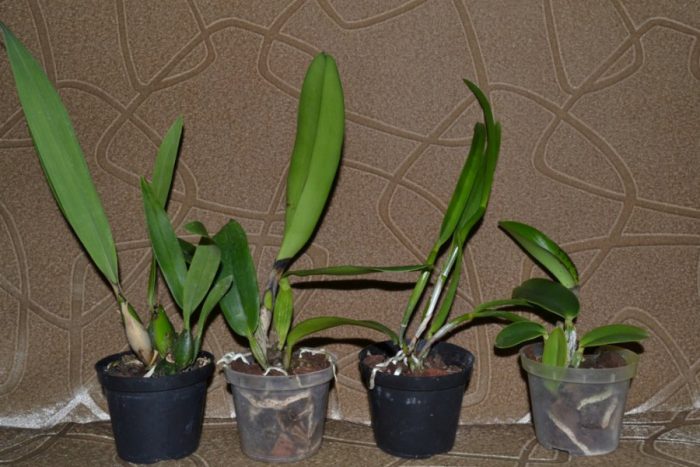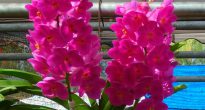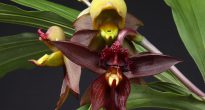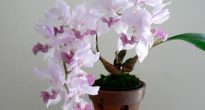The most numerous genus in the orchid family is Epidendrum. So, this genus unites more than 1100 different plant species, among which there are epiphytes, lithophytes and terrestrial species of sympodial orchids. In nature, they can be found in the subtropical and tropical regions of South and North America.
Species of this genus, as a rule, have obvious differences from each other, which lie both in size and in appearance. However, each of the species has branched short rhizomes (aerial modified creeping shoot), and they also have tough, rather thick, almost succulent vaginal leaves. These leaves can be located in the upper part of small pseudobulbs in pairs or alternately on erect, thin stems. There are species in which the leaves have a linear-lanceolate shape and a pointed tip, and they are also slightly folded along the central vein, while others have broad-oval leaf plates with a concave shape, similar to a boat or a scoop. Apical peduncles are most often multi-flowered, they bear dense inflorescences in the form of a ball or brush, however, some species have single-flowered inflorescences or loose spicate, consisting of only a few flowers. Flowers with a rich color can be either large (up to 14 centimeters in diameter) or rather small (1 to 4 centimeters in diameter). 3 sepals (sepals) and 2 true petals (petals), as a rule, have a similar color and shape. A rather large complex lip (3rd petal) near the base is rolled into a tube.
Epidendrum orchid care at home
The epidendrum is not yet very popular among Russian flower growers. However, in foreign flower shops there is a huge selection of such orchids, both various hybrids and species. This plant is recommended for experienced growers, while beginners can have many problems with it.
Illumination
It needs bright lighting all year round, but the flower should be protected from direct sunlight. It is recommended to place it on the windowsill of the western or eastern window.If the flower is on a south-facing window, then at noon it should be shaded from the scorching sun's rays.
It is not recommended to place an epidendrum on the window in the northern part of the room, because there is very little light there even in the summer. However, the flower will normally grow and develop in such a place if it is provided with supplemental lighting with phyto lamps, the illumination level should be 6000 lux, and the daylight hours should have a duration of 10 to 12 hours. It is also recommended to use supplementary lighting with phytolamps in autumn and winter (especially in the evening).
Temperature regime
This plant needs a moderate to moderately warm temperature regime. In this case, it is imperative to ensure the difference in daily temperatures. Best of all, if in the daytime the room will be from 18 to 25 degrees, and at night - from 12 to 16 degrees, it should be noted that the temperature difference should be at least 6 degrees.
From spring to autumn, the plant can be outdoors (in the garden, on the balcony) if there is no threat of frost at night. He needs to provide protection from direct sunlight and precipitation. This is the easiest way to ensure the correct temperature regime for such an orchid.
Earth mix
The way in which the epidendrum should be grown directly depends on the species. So, large-sized species (for example, rooting epidendrum) are recommended to be grown in pots, and compact species (for example, sickle-shaped epidendrum) - on blocks. A suitable dredge consists of medium-sized pieces of pine bark, peat, sphagnum and a small amount of charcoal. A large piece of pine bark is used as a block on the surface of which the rhizome and the root system of the flower are fixed. To prevent the liquid from evaporating very quickly, you need to cover them with a not too thick layer of sphagnum.
How to water
For irrigation, use well-settled soft water, the temperature of which should be from 30 to 45 degrees. It is recommended to water the plant by dipping the pot or block into a basin filled with water. After 20-30 minutes, the orchid needs to be removed, wait until all excess liquid has drained off and return it to its place.
It is recommended to water the plant after the bark is almost completely dry (complete drying cannot be allowed).
Humidity
Too high air humidity is not required, 50-70 percent is optimal. To ensure such humidity, it is recommended to pour expanded clay into the pallet and pour in a little water, while 2 times a day it is necessary to moisten the foliage from the sprayer.
Transplant features
The transplant is carried out 1 time in 3 or 4 years, after the substrate (block) has strongly acidified or decomposed. It is recommended to replant immediately after the plant stops blooming.
Fertilizer
Fertilize once every 2 or 3 weeks. To do this, use a special complex fertilizer for orchids. The fertilizer is dissolved in water for irrigation (see the concentration on the package).
Dormant period
The plant does not have a rest period.
Reproduction methods
The breeding method depends on the species. So, it can be propagated by children that grow on shoots, by dividing the rhizome or by rooting the apical part of the flower, on which there should be aerial roots.
When dividing a bush, it must be remembered that at least 3 developed pseudobulbs or shoots should remain on each plot. The baby should be separated from the maternal shoot only after it has grown several sufficiently large roots.
Pests and diseases
Resistant to pests. Such an orchid is sick most often due to violations of the rules of care. For example: rotting of the pseudobulbs and the root system with too much watering, the appearance of burns on the leaves due to direct rays of the sun, with poor lighting - the lack of flowering, etc.
Main types
Below is a description of the main types of such an orchid, however, various hybrids are most popular among flower growers.
Rooting Epidendrum (Epidendrum radicans)
This lithophyte can be found in nature in the humid forests of Colombia, as well as Mexico. This plant differs in that it has many aerial roots growing over the entire surface of completely leafy thin shoots, which are often longer than 50 centimeters. The leaflets pointed at the tips have a narrow elliptical shape and a length of approximately 10-14 centimeters. On multi-flowered peduncles there are inflorescences that have the shape of a ball and consist of bright red flowers, reaching a diameter of 4 centimeters. The oval-pointed sepals are one and a half centimeters long and 5 millimeters wide. Wider petals are almost diamond-shaped. The pronounced three-lobed lip is similar to a flying bird, it has fringed lobes that are almost rectangular in shape, while the one in the center is bifurcated at the tip. In the central part of the lip, in the throat of the tube, there is a speck of saturated yellow color.
Epidendrum cross or ibaguisky (Epidendrum ibaguense)
Such a terrestrial species can be found in nature in South and Central America. It is similar to the rooting epidendrum, however, in such a plant, aerial roots grow only at the base of the shoot. It is also distinguished by a variety of colors of flowers, for example: red, yellow, orange and light purple.
Epidendrum cilia (Epidendrum ciliare)
In the wild, it is found in the tropical regions of Central America. This plant is a medium-sized epiphyte, in which the pseudobulbs have a clavate shape and are univalent or double-leaved. The oblong-elliptical leaflets can be up to 15 centimeters long. Multi-flowered peduncles have apical inflorescences in the form of brushes. Fragrant flowers are quite large, their diameter is 9 centimeters. Yellowish-green sepals and petals are very narrow, lanceolate-filiform. The pronounced three-lobed lip is painted white. At the same time, its wide, fringed lateral parts are strongly indented and similar to disheveled feathers, and the long lobe located in the center is narrow, elongated and pointed, similar to a spear.
Epidendrum ivory (Epidendrum eburneum)
This epiphyte can be found in nature only in Costa Rica, Nicaragua and Panama. Rounded erect shoots reach a height of 20–80 centimeters. On their surface there are tubular film shells that remained from fallen leaves. Narrow elliptical leaflets reach 11 centimeters in length and 2–2.5 centimeters in width. On little-flowered short peduncles there are 4–6 fragrant flowers of rather large size (diameter about 6 centimeters). Narrow lanceolate, almost filiform sepals and petals are ivory (light ocher). A fairly large, whole, heart-shaped lip reaches 4 centimeters in width. It is painted white, and there is a yellowish speck next to the pharynx.
Epidendrum sickle (Epidendrum falcatum)
This lithophyte is endemic to Mexico. This view is quite compact. Single-leaved, thin pseudobulbs in height can reach 4-8 centimeters. The drooping leaves of a linear-lanceolate shape in length can be from 10 to 30 centimeters. Single flowers reach 8 centimeters in diameter. The whitish-green sepals and petals are narrow-lanceolate. The three-lobed snow-white lip consists of lateral wide rhomboid parts, which are slightly curved along the outer edge, as well as a narrow central part of the belt-like shape. There is a small yellow speck in the mouth of the tube.




















